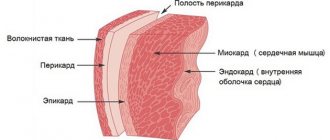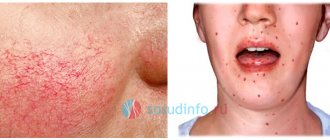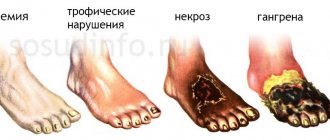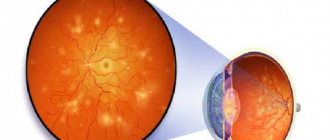External manifestations
The cause of blue skin is pathological hemoglobin accumulated in the blood, depleted of oxygen. Blue discoloration of parts of the body does not affect health, but this phenomenon indicates that the patient needs emergency medical care.
Manifests itself in the following diseases:
- heart disease and respiratory diseases;
- venous insufficiency and Raynaud's disease;
- oncology, neuralgia, pancreatitis;
- with chest deformation;
- for food poisoning;
- plague, cholera, drug and alcohol overdose.
Blueness of the skin is often accompanied by the following symptoms:
- tachycardia;
- cough, shortness of breath;
- feverish condition;
- fever, weakness;
- varying degrees of pain.
Blue skin on certain parts of the body means:
- nasolabial triangle – congenital heart defect, heart disease;
- skin around the eyes – physical fatigue, exhaustion, nervous breakdown;
- genital organs - age-related changes;
- cervix - pregnancy;
- skin – poor circulation.
The blueness of the skin is affected by gas exchange between blood and oxygen, the speed of blood movement in the vessels and the body’s ability to bind oxygen to hemoglobin.
What external conditions cause cyanosis?
Skin cyanosis can be physiological in nature during overload hypoxia in healthy people. Heavy physical activity, stress, elevated temperature require more oxygen, tissues consume up to 90% of the volume instead of 25% under normal conditions. The acidosis that develops during muscle work contributes to the severing of the bond between hemoglobin and oxygen molecules.
For this reason, we see a slight blueness of the lips in a tired person. After rest, it disappears as the body gradually restores the necessary balance.
Taking into account the pathological conditions of development, we can distinguish between exogenous and endogenous oxygen deficiency.
Exogenous hypoxia occurs when a person finds himself in conditions of low oxygen content in the inhaled air. Similar situations arise with mountain sickness, when inexperienced climbers or poorly trained tourists consider themselves ready to climb the next peak.
The symptoms were first described in historical chronicles of the 16th-17th centuries during the conquest of South American lands by the Spanish conquistadors
The soldiers suffered from suffocation and had gray-blue faces. Cyanosis of the face of the inhabitants of lowland Europe did not extend to the aborigines, adapted to the conditions of the highlands.
Modern studies have shown that already from an altitude of 2000 m the oxygen content in the blood begins to fall. Cyanosis of the skin can be pronounced at an altitude of 4000 m (blood saturation loses 1/5 of the oxygen), and the threshold altitude is considered to be 6000 m. No adaptation helps here. Special masks with humidified oxygen are required.
Diffuse cyanosis is found in those killed during depressurization of aircraft cabins, in emergency situations during diving operations, and in miners in mountain rubble. Rescuers see a pronounced change in the color of the skin of the victims’ faces, limbs, and torso.
Causes of skin cyanosis during pregnancy
One of the signs of pregnancy is darkening of the external genitalia and cervix. Their color takes on a blue tint, this is due to changes in physiological processes in the pelvis.
During pregnancy, blood circulation takes on a different character, providing the unborn child with conditions for full development.
The veins fill with blood as much as possible, which causes a change in the color of the mucous membrane of the female organs.
Changes in the color of the genitals do not only appear during pregnancy. This may be the beginning of oncology, chlamydia, mycoplasma, viral and fungal diseases. Each of these diseases causes excessive plethora of the small pelvis.
Symptoms
characteristic zones of cyanosis
Cyanosis is a symptom of life-threatening diseases. With central cyanosis, the skin of the periorbital and perioral areas first turns blue, then it spreads to areas of the body with the thinnest skin. Peripheral cyanosis is most pronounced in areas distant from the heart. It is often combined with swelling and swelling of the veins of the neck.
Depending on the time of occurrence, cyanosis can be acute, subacute and chronic.
Cyanosis does not have a negative impact on the general well-being of patients, but in combination with other signs of the underlying pathology it becomes a reason to consult a doctor. If cyanosis occurs suddenly, increases rapidly and has a significant degree of severity, then it requires emergency care.
Cyanosis, depending on the etiology of the disease, is accompanied by various symptoms: severe cough, shortness of breath, tachycardia, weakness, fever and other signs of intoxication.
- Cyanosis in bronchopulmonary diseases is manifested by a purple tint of the skin and mucous membranes and is combined with shortness of breath, wet cough, fever, sweating, and moist rales. These symptoms are characteristic of an attack of bronchial asthma, acute bronchitis and bronchiolitis, pneumonia. With pulmonary embolism, intense cyanosis develops against the background of chest pain and shortness of breath, and with pulmonary infarction it is combined with hemoptysis. Severe cyanosis and severe shortness of breath are signs of tuberculosis and lung carcinomatosis. Patients with similar symptoms require urgent hospitalization and respiratory resuscitation.
- In heart disease, cyanosis is one of the main symptoms. It is combined with shortness of breath, characteristic auscultatory findings, moist rales, and hemoptysis. Cyanosis with heart defects is accompanied by secondary erythrocytosis, increased hematocrit, and the development of capillary stasis. Patients experience deformation of fingers like drumsticks and nails like watch glasses.
cyanosis in a newborn with a heart defect and the characteristic structure of the fingers of an adult with an untreated defect
Cyanosis of the nasolabial triangle in a child occurs both normally and in pathology. In newborns, the skin is so thin that the blood vessels are visible through it. Severe, persistent cyanosis requires urgent attention to a pediatrician.
Cyanosis is not subject to special treatment. When it appears, oxygen therapy is carried out and the main treatment is intensified. Therapy is considered effective when the severity of cyanosis decreases and disappears.
In the absence of timely and effective treatment for diseases manifested by cyanosis, patients develop a disorder of the nervous system, the general resistance of the body decreases, sleep and appetite are disturbed, and in severe cases the person may fall into a coma. This condition requires emergency medical care in the intensive care unit.
Cyanosis of the skin
It appears as a symptom of obstruction of arterial vessels - a life-threatening disease.
With insufficient oxygen saturation of the bloodstream, the blood thickens, its movement through the veins slows down, it thromboses, as a result of which the skin acquires a dark tint. The rate of reduced hemoglobin should be 30 g/l; at a higher concentration, cyanosis develops. At this concentration, it is hidden; if the content of pathological hemoglobin exceeds 45 g/l, blue spots appear on the body.
Eliminated by complex treatment, bringing the amount of reduced hemoglobin in the blood back to normal.
Mucous
By studying the color of the mucous membrane, its consistency and density, the doctor determines the cause of the color change. Blue mucous membranes are caused by:
- inflammatory processes;
- infectious diseases;
- fungal infection;
- intoxication of the body;
- hypothermia:
- mechanical injuries;
- asphyxia;
- chronic diseases.
Blue nose
The skin of the nose turns blue due to poor circulation in the capillaries - thin blood vessels. This mainly occurs due to intoxication of the body, in which sulfagemoglabin appears in the blood, which cannot transport oxygen through the veins, since it contains ferric iron.
Due to insufficient regulation of the autonomic system, small vessels spasm, condensed blood accumulates, which causes blue skin - acrocinosis.
With this condition of the skin, the therapist refers you to a rheumatologist or angiosurgeon for consultation.
Diagnosis of pathology
There is no direct treatment for cyanosis. To eliminate all symptoms, it is necessary to identify the provoking disease and get rid of it. To do this, the first thing you need to do is go to the doctor.
The doctor's actions will be as follows:
- Examining the patient and listening to complaints.
- The doctor finds out when the signs appeared, whether they are constant or occur periodically.
- The doctor finds out the presence of chronic pathologies.
- Prescribes special studies, such as:
- General blood analysis.
- Determination of blood gas composition.
- Pulse oximetry.
Modern research methods allow you to quickly determine the causes of the disease
- The speed of blood flow is determined.
- A study of the functioning of the lungs and heart is carried out.
- ECG.
- X-ray examination.
- Computed tomography of the chest.
Remember. Only after establishing the cause of cyanosis can treatment begin that will help eliminate the manifestations of this condition.
Types of cyanosis
Based on the characteristic signs of manifestation and localization, cyanosis is divided into several types.
| Type of cyanosis | Reasons, how it manifests itself |
| Diffuse | In case of impaired blood circulation and pathological processes in the respiratory system, it is localized throughout the body |
| Peripheral | Poor functioning of the heart muscle causes ischemic manifestations of the limbs and convex parts of the face |
| Local | Appears in certain organs with poor blood circulation |
| Acrocyanosis | When venous circulation stagnates, blue discoloration of the ears, lips, and fingers is observed. Thrombophlebitis - a type of acrocyanosis |
Cordial
May be triggered by prolonged exposure to a stuffy room.
Heart failure causes an increased level of reduced hemoglobin in the blood and gives it a dark color with a hint of blue.
The blood passing through the lungs does not receive enough oxygen and thickens and darkens. The contractile function of the myocardium deteriorates, which causes a slowdown in blood flow with a simultaneous increase in the amount of blood.
Capillaries, with the slow flow of the bloodstream, absorb more and more oxygen, which leads to oxygen starvation of other tissues. Hypoxia disrupts the acid balance of the blood and causes acidosis.
Respiratory
If the functioning of the bronchopulmonary system is disrupted, oxygen does not enter the lungs in the required volume, its movement along the respiratory channel is slow, this causes hypoxia.
In asthma, a local type of cyanosis appears, lips, cheeks, and ears turn blue.
In the initial stage it is easy to eliminate - it is unstable, increases with nervous excitement, and decreases in a calm state.
Respiratory is the only type of cyanosis that disappears within a few minutes after oxygen therapy.
Cerebral
It occurs when the blood is unable to combine hemoglobin with oxygen.
In this case, brain cells receive blood with a small amount of oxygen, which leads to the development of ischemia of the cellular structure of the brain. Against this background, dementia, epilepsy, cerebral hemorrhages, eye diseases, and even loss of vision develop.
Hematological
Occurs with pathological blood diseases. The pathology can be congenital and transmitted at the genetic level or develops against the background of:
- anemia:
- carbon monoxide poisoning, carbon monoxide poisoning and other sources of fumes;
- water balance disturbances.
Metabolic
Occurs with a lack of calcium salts in the plasma and with hyperphosphatemia.
With tissue hypoxia, metabolic cyanosis develops, in which body tissues are not capable of absorbing oxygen. It appears in a combination of peripheral and cardiac cyanosis.
This is a mixed form of the disease and, when prescribing treatment, both types are taken into account.
Classification
Peripheral cyanosis.
On the left - normal skin color, on the right - cyanotic brush. Depending on the origin, cyanosis can be of the following types:
- cardiac - caused by unproductive blood circulation and insufficient blood supply to the tissues and oxygen deficiency;
- respiratory - caused by an insufficient amount of oxygen in the lungs and a violation of its flow into the blood, other tissues and organs;
- cerebral - caused by the inability to attach oxygen to hemoglobin and leads to ischemia of brain cells;
- hematological – caused by blood pathologies;
- metabolic - caused by a violation of oxygen absorption by tissue cells.
As a rule, only respiratory cyanosis can disappear 10 minutes after oxygen therapy. Other types last longer.
Depending on the speed of appearance of cyanosis, it happens:
- spicy;
- subacute;
- chronic.
According to the nature of distribution, experts distinguish the following types of cyanosis:
- central (or diffuse) - manifests itself over the surface of the entire body, caused by impaired respiratory function or general circulatory disorders;
- peripheral - provoked by dysfunction of the heart or arteries and the development of ischemia of the tissues of the arms, legs or face;
- acrocyanosis - cyanosis appears only at the “extreme points” (fingertips, wings of the nose, ears, lips), its appearance is provoked by venous stagnation and is observed in chronic heart failure;
- local - detected during examination of the nasopharynx, pharynx or genitals and is caused by stagnation of blood.
How to treat
Manifestations of cyanosis accompany the underlying disease that caused it. A therapist or cardiologist will help you find out the cause. Before prescribing treatment, the disease is diagnosed. For this purpose they prescribe:
- blood test - gas and clinical;
- spirography and pulse spimetry;
- cardiogram and echocardiogram;
- chest x-ray;
- tomography of the respiratory organs.
For a more accurate diagnosis, additional examinations are prescribed.
The main direction in treatment is to restore oxygen metabolism in tissues.
Oxygen therapy is used for acute cyanosis - it will quickly relieve attacks of bluish skin. In chronic cases, a positive effect will appear with longer oxygen therapy.
If the skin is constantly blue, this indicates congenital heart defects or blood diseases, which can be eliminated surgically or by long-term therapeutic treatment methods.
Oxygen therapy
Using oxygen therapy, the blood is additionally saturated with oxygen, which leads to a reduction in the bluishness of the skin.
The oxygen mixture and the method of its delivery are selected for each patient individually.
Methods of treatment with oxygen therapy:
- forced ventilation;
- oxygen mask and nasal catheters;
- barotherapy and oxygen tent.
Filling the body with oxygen is carried out on an outpatient basis or in a hospital. Oxygen cocktails and oxygen baths are recommended for sanatorium treatment.
Medicines
Cyanosis appears in various pathological conditions, so only a doctor can make the correct diagnosis and prescribe treatment. Medicines that are used in the treatment of diseases that cause cyanosis:
- analeptics;
- glycosides;
- neuroprotectors;
- antihypoxants;
- bronchodilators;
- complexes of vitamins and microelements.
In acute cases of the disease, hospitalization is necessary.
Nutrition
You should categorically give up bad habits - drinking alcohol and smoking.
Eliminate fatty and spicy foods from your diet. Eat more plant foods, vegetable and fruit juices.
Avoid foods that cause cholesterol plaques.
Take infusions of medicinal herbs that help thin the blood.
Exercise
During oxygen starvation, blood flow is restored by moderate physical exercise, as well as:
- outdoor games;
- swimming;
- easy jogging;
- walking;
- going out into nature.
Physical exercises must be coordinated with your doctor so that excessive exercise does not worsen the course of the disease.
Blue discoloration of the epidermis cannot be ignored - this is an alarming signal from the body, and is a symptom of diseases for which it is necessary to immediately consult a doctor. The sudden appearance of cyanosis requires calling an ambulance and immediate hospitalization.
Diagnosis and treatment of cyanosis
When diagnosing cyanosis, immediately pay attention to a number of indicators:
- duration of onset of first symptoms
- taking medications that can reduce hemoglobin derivatives
- diseases of the respiratory and cardiovascular systems indicate central cyanosis
Massage the extremities of the arms and legs, so the skin blood flow becomes faster and peripheral cyanosis disappears, unlike the central one. To recognize the disease, it is also necessary to take a blood test.
First of all, you need to undergo an examination and identify the causes of the disease. Cyanosis in general is treated with an oxygen mask or an oxygen tent, which helps saturate the blood with the necessary oxygen. The more effective this method is, the faster the bluish tint of the skin will decrease.
But do not forget that it is initially worth treating the disease that caused the cyanosis. The attending physician will be able to determine the exact cause of cyanosis and prescribe medications and medications necessary to eliminate or alleviate the cause of cyanosis itself.











